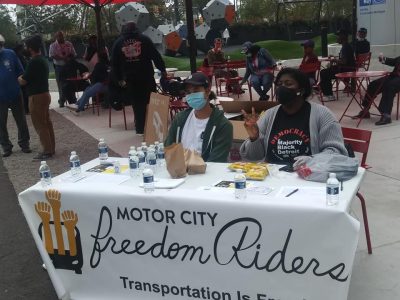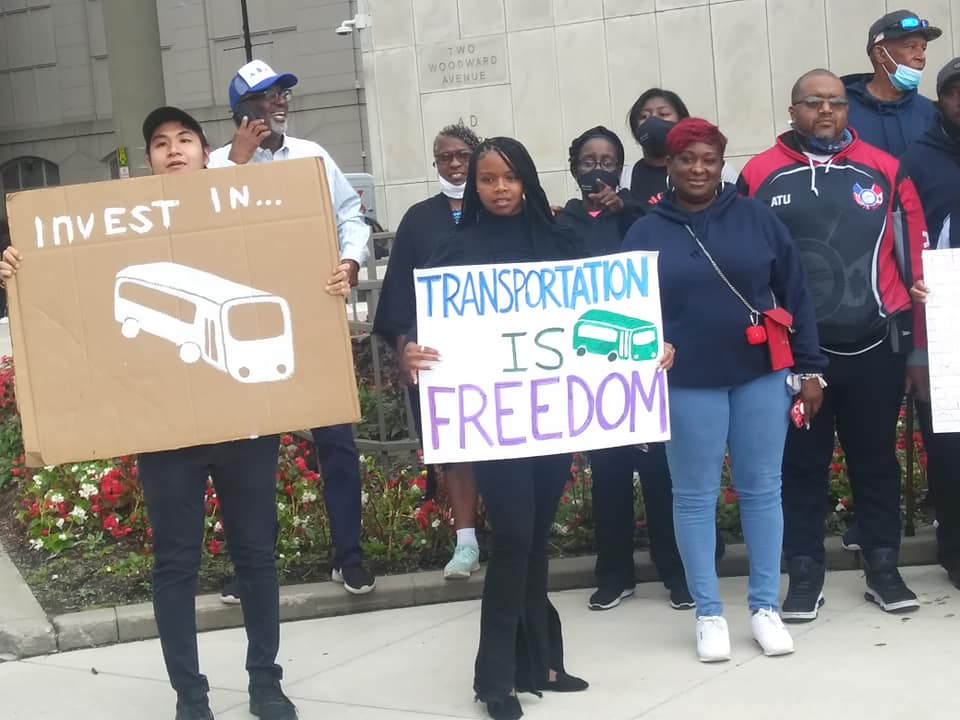Economic and Social Chaos in America. Public Transportation Cuts Leave Millions Stranded
Commuters and workers are facing another crisis in the aftermath of the economic caused by the pandemic

All Global Research articles can be read in 51 languages by activating the “Translate Website” drop down menu on the top banner of our home page (Desktop version).
Visit and follow us on Instagram at @crg_globalresearch.
***
Since the beginning of the lockdowns in March 2020, the impact on public transportation networks, their commuters and workers has been disastrous.
The outbreak of COVID-19 crisis has dealt a heavy blow to the already fragile United States economy.
Over 20 million people were thrown out of their jobs between March and June of last year while tax revenues generated by municipal, state and the federal governments took a drastic turn downward due the closing of many businesses and public institutions which relied on in-person customer service. With many people either laid off or mandated to work from home due to the pandemic, the ridership on all forms of public transport declined sharply.
Even though labor statistics indicate that many millions have returned to work, millions of others have witnessed their places of employment severely trim staff. At the same time, with the permanent closings of an estimated 200,000 small and medium-size business enterprises, many jobs will be lost forever.
A jobs report for the month of September stated that only 194,00 new jobs were created for the workers in the U.S. Many of the jobs that have been created since the emergence from the Great Recession of the last decade are in the low-wage category. This trend is undoubtedly continuing as the enhanced unemployment benefits have been discontinued by the states and the federal government.
Political officials at the aegis of business interests began criticizing the extended jobless benefits saying they were providing incentives for people to remain at home rather than reenter the labor market. Yet these programs were essential in preventing a complete economic collapse on the level of the Great Depression of 1929-1941.
Considering the massive cutbacks in public transportation and the lack of funding for childcare services, large numbers of workers face considerable difficulties in returning to many of the low-wage jobs which are available to them.
Moreover, millions remain ill after contracting COVID-19 themselves along with the trauma of losing close relatives, friends, neighbors and co-workers. More than 700,000 people have died of the infectious disease over the last 19 months out of a total of 44.5 million cases.
The mounting crisis of public transportation services was recognized during the first few months of the pandemic and the subsequent economic decline. An article published in vox.com during December noted:
“In the early days of the pandemic, public transit ridership dropped precipitously. Americans were urged to stay home, which prompted transit agencies to swiftly implement service cuts to match this declining demand. Transit networks needed a financial lifeline. Fare money was drying up, and existing budget gaps were further exacerbated. Through the CARES Act in March, local agencies received $25 billion in aid — bailout money that was crucial to keep networks operating through the summer despite steep declines in revenue from riders, advertisers, and taxes as people stayed home.”
Fares for buses and trains have never provided municipalities with the necessary revenue to maintain a thriving public transportation system. Subsidies from municipal, state and federal budgets are indispensable in the maintenance of public transport networks.
Those who are able to work from home, largely people employed in higher-income sectors of the labor market, will not be as adversely impacted by the cancelling of routes, the slow-down in the frequency of service and the elimination of employees. However, many people who are considered “essential workers” are in the low-income categories and rely on public transport because they may not own automobiles to take them to work, school, medical appointments, shopping and to visit friends and relatives.
Disproportionately the low-wage workers considered essential to the operations of the national economy are from the African American, Latinx, immigrant and other people of color communities. Therefore, the problems being generated by the cutbacks in public transportation have both racial and class dynamics.
Detroit Riders and Drivers Rally Downtown Demanding a Reversal of Cuts
On October 5 the Motor City Freedom Riders (MCFR) hosted a press conference and rally right outside City Hall in downtown Detroit. The MCFR has served as community advocates for the improvement and expansion of public transportation in Detroit and throughout southeastern Michigan.
Present at the event was the President of the Amalgamated Transit Union (ATU) Local 26, Glenn Tolbert, who spoke to the crowd about the monumental challenges facing bus drivers during the current period. Many bus drivers have contracted COVID-19 while at work leading to several deaths.
Pay for the ATU Local 26 workers has not kept apace with the rising cost of living in the city of Detroit where the burden of over assessed property taxes and rising rents serve to drive people away from living in the municipality. Detroit bus drivers were only awarded “hazard pay” for two months during the first few weeks of the pandemic in 2020. Tolbert mentioned that the suburban Southeast Michigan Regional Transit Authority (SMART) drivers make ten dollars per hour more than those working for the Detroit Department of Transportation (DDOT).
Detroit activists and union members hold rally to protest cuts in public transportation, Oct. 5, 2021 (Source: Abayomi Azikiwe)
In September the DDOT officials announced a series of cuts in service in the city which has perhaps one of the worst public transportation systems in the U.S. Popularly known as the Motor City, Detroit has since the mid-1950s consistently reduced investment in bus and rail services encouraging the purchase of automobiles to fuel the profits of the car industry.
Thomas Zerafa, a longtime public transportation advocate and board member of the Michigan Coalition for Human Rights (MCHR), spoke at the rally stating that he was old enough to remember the discontinuation of the streetcar rail services in 1956. A public transportation system prior to the late 1950s encompassed bus and rail routes which extended through large sections of Detroit and the region.
The Q-Line, a hybrid rail service along Woodward Avenue between West Grand Boulevard and the Riverfront, was opened in 2017. The Q-Line construction was largely opposed by most bus riders since it only covered a limited geographic area which has been targeted for gentrification over the last decade. Even this prestige project was closed down after March 2020. The rail line only began servicing customers again in September.
MCFR at the press conference and rally circulated what they described as a “City of Detroit Transit Platform”. The document has seven important demands related to public transportation issues in the city and suburbs.
These demands include raising expenditures by 300% for the bus services in order to hire more drivers and to increase the frequencies of routes. Another important call was made for greater accessibility for people living with disabilities and the construction of more enclosed bus stops with route information being available at each location.
Other issues raised were the demand to reduce fares for seniors, Medicare recipients, and students. The MCFR wants a pilot project with no far routes which would eventually lead to the elimination of cost for riders within ten years.
In regard to the labor force, the document says:
“DDOT is currently experiencing a driver shortage which means that only 70% of scheduled buses are actually leaving the terminal. Drivers should have wage parity with SMART drivers in order to prevent them from leaving for better paying jobs. They should also implement retention programs to keep drivers on staff once they complete their training.”
The two final demands propose better land use policy and coordination with the SMART and the Regional Transit Authority (RTA) in order to facilitate better services for riders and drivers throughout the city and suburbs. Finally, the question of planning democracy was raised demanding that riders and drivers be consulted in regard to route changes and other major policy changes.
Federal Responsibility and Corporate Obligations
The City of Detroit has received over $800 million in recovery funds under the American Rescue Plan (ARP) enacted by the U.S. Congress and signed into law by President Joe Biden. Therefore, in Detroit and other municipalities people are wondering why cuts in service and the failure to increase salaries are the dominant themes being discussed by local and state governments.
In order for any economic recovery to have sustainability there must be huge investments into public infrastructure in the transportation, educational, environmental, housing and healthcare sectors of the U.S. At present the U.S. Congress has been incapable of agreeing on a multi-trillion dollars infrastructure plan which could address some of these pressing problems.
Corporate interests including the financial institutions have systematically fostered the large-scale disinvestment in public transportation. Consequently, mass organizations in the urban and suburban areas of the country must mobilize to demand that the needs of the workers and oppressed are met in the present period.
*
Note to readers: Please click the share buttons above or below. Follow us on Instagram, @crg_globalresearch. Forward this article to your email lists. Crosspost on your blog site, internet forums. etc.
Abayomi Azikiwe is the editor of Pan-African News Wire. He is a frequent contributor to Global Research.
Featured image: Detroit public transportation press conference and rally on Oct. 5, 2021 (Source: Abayomi Azikiwe)


